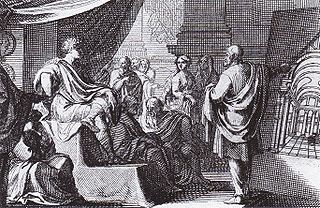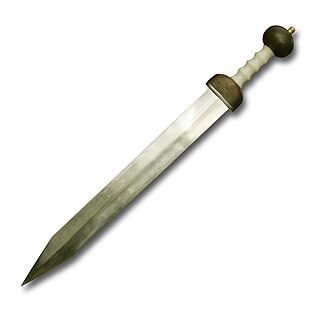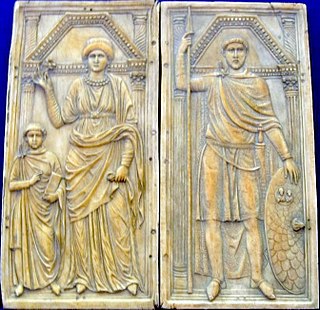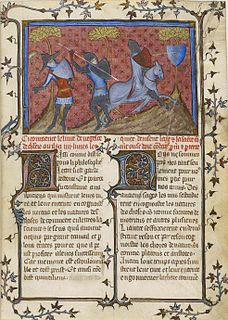
Medieval warfare is the European warfare of the Middle Ages. Technological, cultural, and social developments had forced a severe transformation in the character of warfare from antiquity, changing military tactics and the role of cavalry and artillery. In terms of fortification, the Middle Ages saw the emergence of the castle in Europe, which then spread to the Holy Land.

Marcus Vitruvius Pollio, commonly known as Vitruvius, was a Roman author, architect, and civil and military engineer during the 1st century BC, known for his multi-volume work entitled De architectura. He originated the idea that all buildings should have three attributes: firmitas, utilitas, and venustas. These principles were later widely adopted in Roman architecture. His discussion of perfect proportion in architecture and the human body led to the famous Renaissance drawing of the Vitruvian Man by Leonardo da Vinci.

Gladius is a Latin word meaning "sword", but in its narrow sense, it refers to the sword of Ancient Roman foot soldiers. Early ancient Roman swords were similar to those of the Greeks, called xiphe. From the 3rd century BC, however, the Romans adopted a sword based on the weapons used by the Celtiberians in Hispania late into the Punic Wars, known in Latin as the gladius hispaniensis, or "Hispanic sword".

Flavius Stilicho or Stilico was a military commander in the Roman army who, for a time, became the most powerful man in the Western Roman Empire. He was of Vandal origins and married to Serena, the niece of emperor Theodosius I, and became guardian for the underage Honorius. After many years of victories against a number of enemies, both barbarian and Roman, a series of political and military disasters finally allowed his enemies in the court of Honorius to remove him from power, culminating in his arrest and subsequent execution in 408.
The pilum was a javelin commonly used by the Roman army in ancient times. It was generally about 2 metres long overall, consisting of an iron shank about 7 millimetres (0.28 in) in diameter and 60 centimetres (24 in) long with a pyramidal head. The shank was joined to the wooden shaft by either a socket or a flat tang.
Flavius Theodosius, also known as Count Theodosius or Theodosius the Elder, was a senior military officer serving Valentinian I and the western Roman empire during Late Antiquity. Under his command the Roman army defeated numerous threats, incursions, and usurpations. Theodosius was patriarch of the imperial Theodosian dynasty and father of the emperor Theodosius the Great.

De re militari, also Epitoma rei militaris, is a treatise by the Late Latin writer Publius Flavius Vegetius Renatus about Roman warfare and military principles as a presentation of the methods and practices in use during the height of the Roman Empire and responsible for its power. The extant text dates to the 5th century.

The onager was a Roman torsion powered siege engine. It is commonly depicted as a catapult with a bowl, bucket, or sling at the end of its throwing arm. The onager was first mentioned in AD 353 by Ammianus Marcellinus, who described onagers as the same as a scorpion. The onager is often confused with the later mangonel, a "traction trebuchet" that replaced torsion powered siege engines in the 6th century AD.

Flavia Maximiana Theodora was a Roman empress, wife of Constantius Chlorus.

In the Roman Republic and the Roman Empire, the Latin word castrum referred to a building, or plot of land, used as a fortified military base. In English, the terms "Roman fort", "Roman camp" and "Roman fortress" are commonly used for castrum. However, scholastic convention tends toward the use of the words "fort", "camp", "marching camp" or "fortress" to translate castrum.
Maniple was a tactical unit of the Roman Republic adopted during the Samnite Wars. It was also the name of the military insignia carried by such unit.

The fall of the Western Roman Empire, c. 376–476, was the process of decline in the Western Roman Empire in which the Empire failed to enforce its rule, and its vast territory was divided into several successor polities. The Roman Empire lost the strengths that had allowed it to exercise effective control over its Western provinces; modern historians posit factors including the effectiveness and numbers of the army, the health and numbers of the Roman population, the strength of the economy, the competence of the Emperors, the internal struggles for power, the religious changes of the period, and the efficiency of the civil administration. Increasing pressure from invading barbarians outside Roman culture also contributed greatly to the collapse. The reasons for the collapse are major subjects of the historiography of the ancient world and they inform much modern discourse on state failure.

Si vis pacem, para bellum is a Latin adage translated as "If you want peace, prepare for war".
The comitatenses and later the palatini were the units of the field armies of the late Roman Empire. They were the soldiers that replaced the legionaries, who had formed the backbone of the Roman military since the Marian reforms.
Plumbatae or martiobarbuli were lead-weighted darts carried by infantrymen in Antiquity and the Middle Ages.

De rebus bellicis is an anonymous work of the 4th or 5th century which suggests remedies for the military and financial problems in the Roman Empire, including a number of fanciful war machines. It was written after the death of Constantine I in 337 and before the fall of the Western Roman Empire in 476. Some researchers suggest that it may refer to the Battle of Adrianople of 378, or even the death of Emperor Theodosius I in 395, as it uses the plural form of the word "princeps", the title of the emperor, which may refer to the split of the Empire between Honorius and Arcadius after the death of Theodosius.
A cornicen was a junior officer in the Roman Army. The cornicen's job was to signal salutes to officers and sound orders to the legions. The cornicines played the cornu. Cornicines always marched at the head of the centuries, with the tesserary and the signifer. The cornicines were also used as assistants to a centurion. The cornicen was a duplicary or a soldier who got double the basic pay of the legionary.

Bellifortis is the first fully illustrated manual of military technology written by Konrad Kyeser and dating from the start of the 15th century. It summarises material from classical writers on military technology, like Vegetius' De Re Militari and Frontinus' anecdotal Strategemata, emphasising poliorcetics, or the art of siege warfare, but treating magic as a supplement to the military arts; it is "saturated with astrology", remarked Lynn White, Jr. in a review of the first facsimile edition.

This article lists and briefly discusses the most important of many treatises on military science produced in the Byzantine Empire.

A military treatise or treatise on war is any work that deals with the "art of war" in some basic aspect. Fundamentally military treatises are treatises on military strategy. Other works may also be included in the definition that, although they deal with other topics, include sensitive information about military matters. These may include, among others, description of specific battles, sieges, general campaigns, reports of military authorities, and commented works about ground or naval battles.














